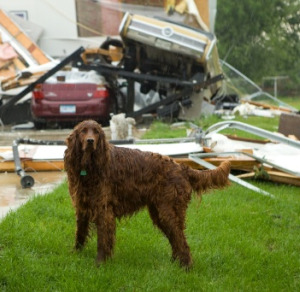Be Responsible for Your Own Pet Emergency Plan

We here in Ulster County recently had a rude awakening. Hurricane Irene brought severe flooding to the area, as it did to other parts of the state. Many of us were under the impression that pet owners being evacuated should not have the same problems as the Katrina people did. After all, post Katrina, it did sound as though FEMA promised that now people would be evacuated with their pets. Wrong! Yes, some subset of shelters in the affected areas did allow pets, but others did not. In our immediate area, the Red Cross shelter would not allow pets to be brought in. As to whether that occurred because of the facility rules at the assigned building or because of the Red Cross, is not clear and has to be investigated, but the point is, in many cases, people were on their own to deal with their pets.
Yet, this does not resolve this case. Because of the catastrophe, the houses that were flooded will not be rehabilitated for 4 to 6 months, and the rentals where the displaced persons are placed have the right to refuse pets. So, if the rental unit refuses to take pets, then what? No volunteer wants to care for additional animals for 4 to 6 months. Besides which, pets do not fair well in a cage for that amount of time. So does the owner then have to surrender them to the organization that has helped rescue them? What do you do? These are not rhetorical questions; these are the realities of dealing with animals in disasters. We all need to think about them.
Several years ago, many of us went to SART and CART disaster training provided by the NYS Agriculture and Markets Department, but the state only provided the training, not the means to address the problems. It is now clear that we, as humane agencies, need to take a serious look at doing something. But in the meantime, each of us needs to make a plan for our own animals. If a hurricane is predicted, which generally brings rain and flooding, we normally have time to plan. We need to use that time wisely. Ensure your pets are wearing collars with ID, or better yet, microchip them. If you are safe in riding out the storm, check to see you have enough staples for you and your animals. Make sure you have all the pets´ medications together. Have your pet carriers at the ready nevertheless. Even better, if you have friends or family on higher ground who would help, transport the animals there. And hope that you can return to your home quickly.
For additional info, go to NYSHA´s website and review the Spring 2005 article on disasters: Be Prepared for a Disaster. For information on dogs in particular, go to the following informative website: http://www.pawnation.com/2011/09/07/natural-disaster-safety-establishing-an-emergency-plan-for-you/.
Remember, your pets rely on you, and you need to rely on yourself — do not assume otherwise. Do not let them down.
New York State Humane Association Humane Review, Vol.XXV, No.2, Fall 2011.